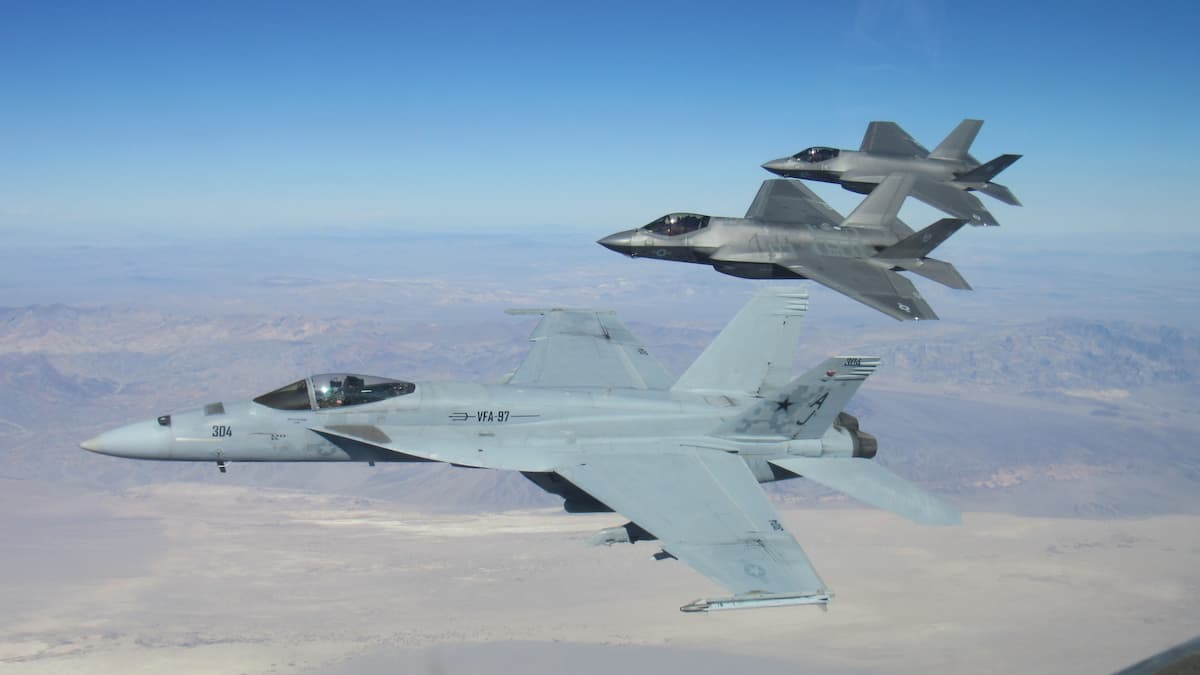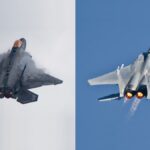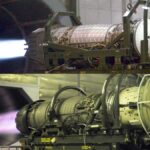2022年5月、トップガン2作目の「トップガン マーヴェリック」が公開されました。
個人的には、映画館のスクリーンで見たい気持ち半分、まだ映画館には行きたくない気持ちも半分と、もやもやした気持ちです。
「トップガン マーヴェリック」の主役機は、F/A-18スーパーホーネットです。
米国空母の艦載機としては、前作のF-14トムキャット以外にも、F/A-18スーパーホーネットのファミリー機でもある電子戦機EA-18G Growlerもありますが、ステルスの艦載機F-35ライトニングIIもあります。
また映画には、最高速度マッハ3世界最速のジェット機SR-71ブラックバードの後継機?でもあるSR-72みたいなDarkstarも登場しています。

映画の世界ながらDarkstarはマッハ10超え、F/A-18スーパーホーネットもミッションで10Gと迫力満点でした。
ここでは、「トップガン マーヴェリック」に関連する空母や艦載機などについて紹介します。
滑走路からの離陸・着陸と空母からの発艦・着艦の違い
同じ戦闘機でも、空港からの離陸・着陸と、空母の甲板での離陸・着陸とでは、その様子は全く別物です。
離陸と発艦の違い
まずは、離陸のイメージを比べてみると、
空港の滑走路から離陸するのは、旅客機の離陸の小型機版みたいなイメージですが、空母からの離陸は、カタパルトによる射出です。
下図は、射出直前の写真で、カタパルトに全脚が固定され機体が沈み込んでいる様子が分かります。蒸気が出ているので蒸気カタパルトです。
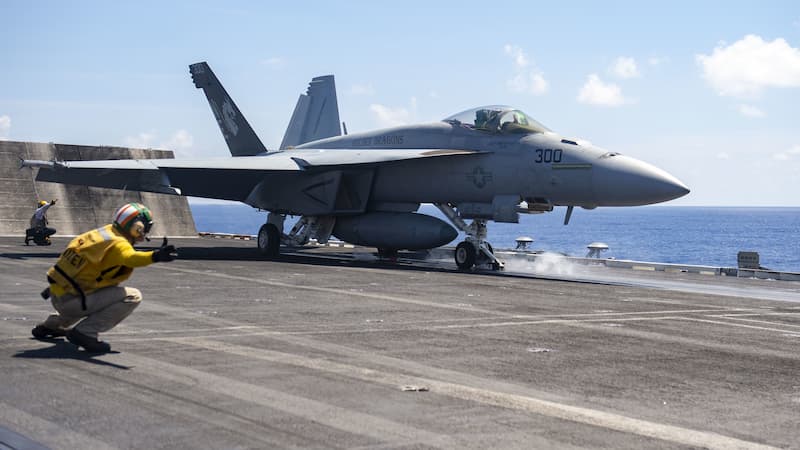
210929-N-IW069-1033 PHILIPPINE SEA (Sept. 29, 2021) An F/A-18E Super Hornet, assigned to the ?Golden Dragons of Strike Fighter Squadron (VFA) 192, launches off the flight deck of the Nimitz-class aircraft carrier USS Carl Vinson (CVN 70), Sept. 29, 2021. The Carl Vinson Carrier Strike Group is on a scheduled deployment in the U.S. 7th Fleet area of operations to enhance interoperability through alliances and partnerships while serving as a ready-response force in support of a free and open Indo-Pacific region. (U.S. Navy photo by Mass Communication Specialist 3rd Class Isaiah Williams)
図1 F/A-18スーパーホーネットのカタパルト射出直前
出典:米国海軍のWebサイト<Resources>Photo Gallery>からの画像
着陸と着艦の違い
着陸、着艦の差はもっと大きな違いがあります。
空港の滑走路には、滑らかに着陸していきます。着地(タッチダウン)もスムーズに滑走路に設置、ブレーキングしていきます。
一方、空母への着艦は、空母は船としては巨大で島のようですが、着陸するパイロットから見ると、針の様に小さいそうです。また、滑走路に比べ短く、しかも、先の無い甲板にぶつけるように着艦し、着艦用のワイヤーにアレスティング・フックを引っ掛けて強制的に止めます。
さらに、アレスティング・フックが引っ掛かからなかった場合には、即離陸できるようにフルスロットルにしないと、甲板の先、つまり、海に落ちてしまいます。
下図は、F/A-18スーパーホーネットの着艦直前の写真です。右側の機体の後部からアレスティング・フックが出ているのを確認できます。スピード感が伝わりませんが、一瞬を切り取って写真です。
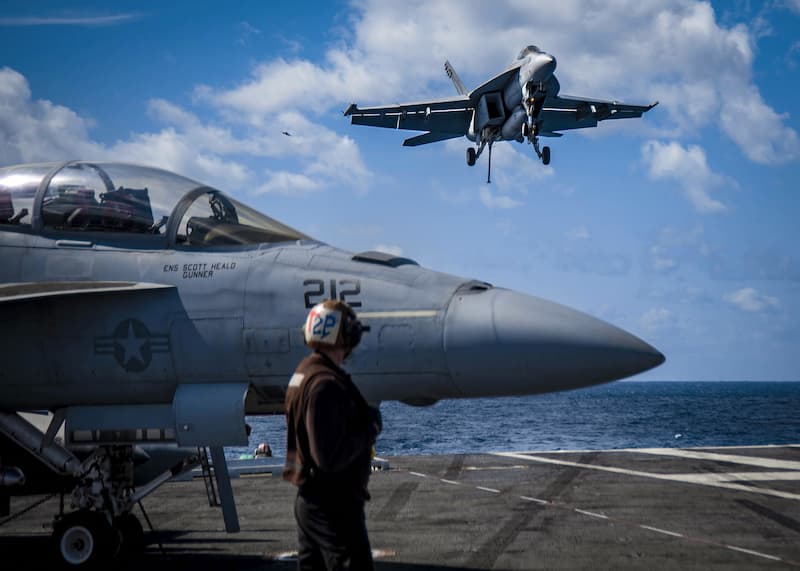
220301-N-UD000-1109 ATLANTIC OCEAN (March 1, 2022) An F/A-18 F Super Hornet, assigned to the “Sidewinders” of Strike Fighter Squadron (VFA) 86, preparers to land on the flight deck of the Nimitz-class aircraft carrier USS George H.W. Bush (CVN 77), March 1, 2022. George H.W. Bush provides the national command authority flexible, tailorable war fighting capability through the carrier strike group that maintains maritime stability and security in order to ensure access, deter aggression and defend U.S., allied and partner interests. (U.S. Navy photo by Mass Communication Specialist 3rd Class Bryan Valek)
図2 F/A-18スーパーホーネットのカタパルト着艦直前
出典:米国海軍のWebサイト<Resources>Photo Gallery>からの画像
艦載機と空軍機との違いは、外見上は脚の構造にも表れます。
艦載機は、頑丈です。離陸や着艦の衝撃に耐えるだけではなく、搭載している武装の重量にも耐える必要があるからです。
下図は、F/A-18スーパーホーネットのファミリー機、EA-18G Growlerの写真です。頑丈そうな脚に見えませんか?
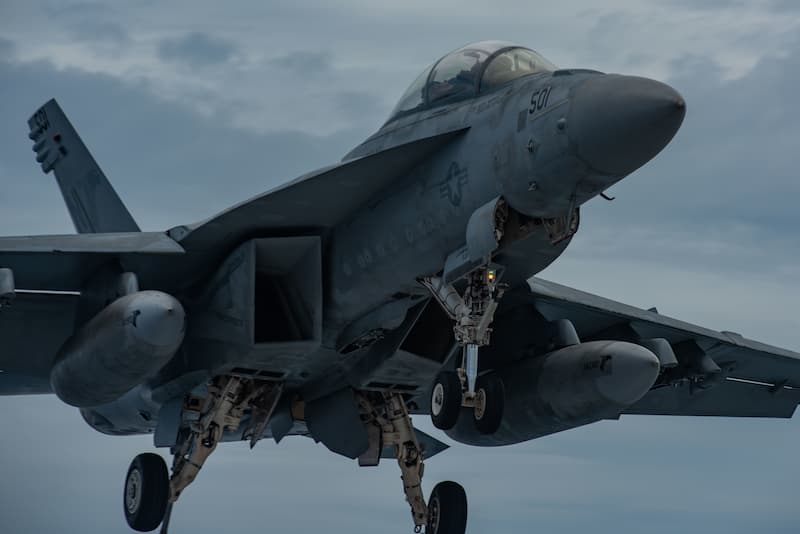
210529-N-ML137-1052 PHILIPPINE SEA (May 29, 2021) An EA-18G Growler attached to the Shadowhawks of Electronic Attack Squadron (VAQ) 141 approaches the flight deck of the U.S. Navy’s only forward-deployed aircraft carrier USS Ronald Reagan (CVN 76). Ronald Reagan, the flagship of Carrier Strike Group 5, provides a combat-ready force that protects and defends the United States, as well as the collective maritime interests of its allies and partners in the Indo-Pacific region. (U.S. Navy photo by Mass Communication Specialist 2nd Class Samantha Jetzer)
図3 F/A-18スーパーホーネットのファミリー機、EA-18G Growlerの脚部
出典:米国海軍のWebサイト<Resources>Photo Gallery>からの画像
地味に見えますが米国の空母のカタパルトは、最先端技術です。詳細は、以下をご参照ください。
映画トップガン2作目の主役機:F/A-18スーパーホーネット
F/A-18スーパーホーネットは、F/A-18ホーネット(レガシー・ホーネット)と比べると、機体も大型化しており別物です。
- F/A-18E/Fはレガシー・ホーネットより25%大きく、機動性、航続距離、ペイロードが向上し、より強力なエンジンが搭載されています。
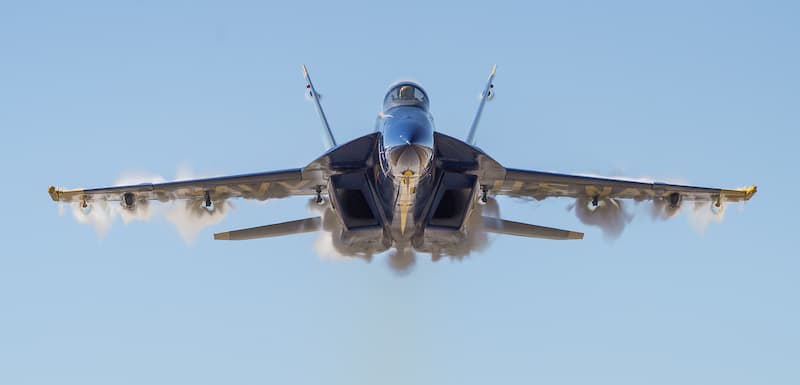
201120-N-YO638-1237 PENSACOLA, Fla. (Nov. 20, 2020) Lead solo pilot Cmdr. Ben Walborn, assigned to the U.S. Navy Flight Demonstration Squadron, the Blue Angels, performs the sneak pass during a training flight over Naval Air Station (NAS) Pensacola. The Blue Angels are conducting training flights over Pensacola to build flight and maintenance proficiency on the new F/A-18 E/F Super Hornet platform and maintain readiness. The 2021 show season will be the Blue Angels’ first year flying the Super Hornet platform as well as the 75th anniversary of the team. (U.S. Navy photo by Mass Communication Specialist 2nd Class Cody Hendrix)
図4 F/A-18スーパーホーネット
出典:米国海軍のWebサイト<Resources>Photo Gallery>からの画像
艦載機としての特徴は、武装等を積んだまま着艦できる能力が高いことと、格納のため主翼を折ることができる構造が目立つところです。
近代化改修もされていて、2021年8月には、米国海軍にF/A-18スーパーホーネットのBlockIII初号機が納入されています。
下図は、レガシーホーネットです。外観ではF/A-18スーパーホーネットとは吸気口の形状が違い、レガシーホーネットは楕円型、スーパーホーネットは角型です。
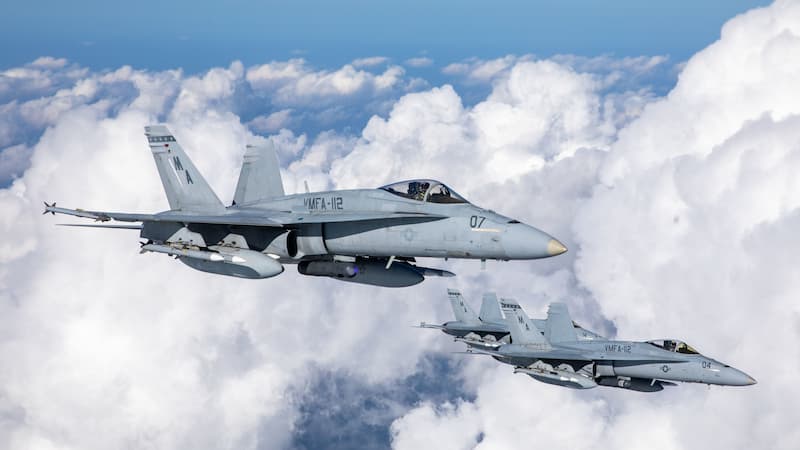
211116-M-TE205-203 JAPAN (Nov. 16, 2021) U.S. Marine Corps F/A-18 Hornet aircraft with Marine Fighter Attack Squadron (VMFA) 112 fly during an aerial refueling exercise in Japan, Nov. 16, 2021. During the exercise, VMFA-112 received fuel from a KC-130J Super Hercules aircraft with Marine Aerial Refueler Transport Squadron 152, extending Hornet?s maximum range capabilities. Marines with VMFA-112, based out of Naval Air Station Joint Reserve Base Fort Worth, Texas are on a rotational unit deployment program at Marine Corps Air Station Iwakuni to maintain regional stability and a free and open Indo-Pacific. (U.S. Marine Corps photo by Sgt. Booker T. Thomas III)
図5 F/A-18レガシーホーネット
出典:米国海軍のWebサイト<Resources>Photo Gallery>からの画像
F/A-18スーパーホーネットについては、以下をご参照ください。
トップガン1作目の主役機F-14トムキャットについては、以下をご参照ください。
自動制御で動く可変翼は、今でも魅力的です。
F-14トムキャットについては、以下をご参照ください。
F/A-18スーパーホーネット・ファミリーの電子戦機:EA-18G Growler
今や必要不可欠な電子戦機が、EA-18G Growlerです。
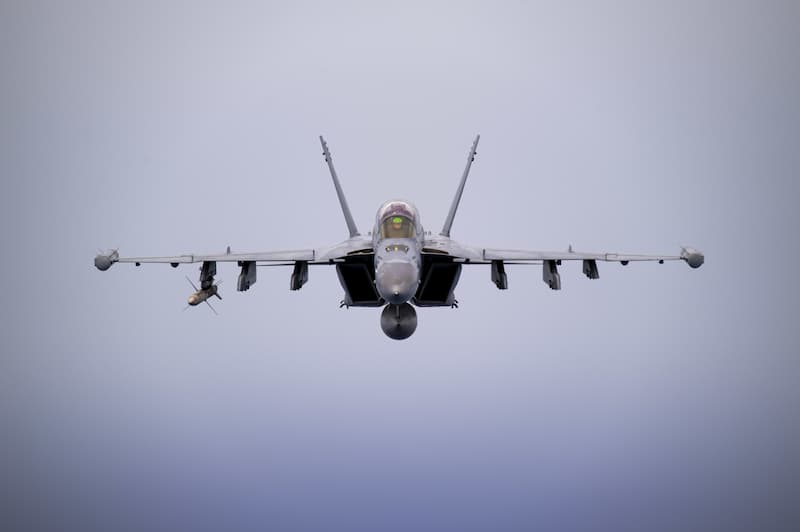
211014-N-HS181-1477 BAY OF BENGAL (Oct. 14, 2021) An EA-18G Growler, assigned to the “Gauntlets” of Electronic Attack Squadron (VAQ) 136, flies over the Bay of Bengal as part of MALABAR 2021, Oct. 14, 2021. MALABAR 2021 is a maritime exercise designed to improve integration, address common maritime security priorities and concerns, enhance interoperability and communication, and strengthen enduring relationships between the Royal Australian Navy, Indian Navy, Japan Maritime Self-Defense Force, and U.S. maritime forces. (U.S. Navy photo by Mass Communication Specialist 2nd Class Haydn N. Smith)
図6 F/A-18スーパーホーネット・ファミリーの電子戦機:EA-18G Growler
出典:米国海軍のWebサイト<Resources>Photo Gallery>からの画像
EA-18G Growlerは、EA-6Bプロウラーの後継機であり、35年以上ぶりの新設計による電子戦機です。
電子戦に特化しているということは、F/A-18スーパーホーネットが搭載する各種武装は自衛のために最小限に抑え、電子戦の装備つまりレーダーや対レーダーシステムなどを搭載しています。
F/A-18Fスーパーホーネット同様ブロックIII化も進められています。
EA-18G Growlerについては、以下をご参照ください。
ステルス機:F-35ライトニングII
艦載機にもステルス機があります。
F-35ライトニングIIは、空軍用にF-35A、海兵隊用にF-35B、海軍様にF-35Cと3タイプあります。
- 標準タイプが空軍のF-35A
- 垂直離着陸可能な海兵隊のF-35B
- 艦載機で頑丈で翼を折れる海軍のF-35C
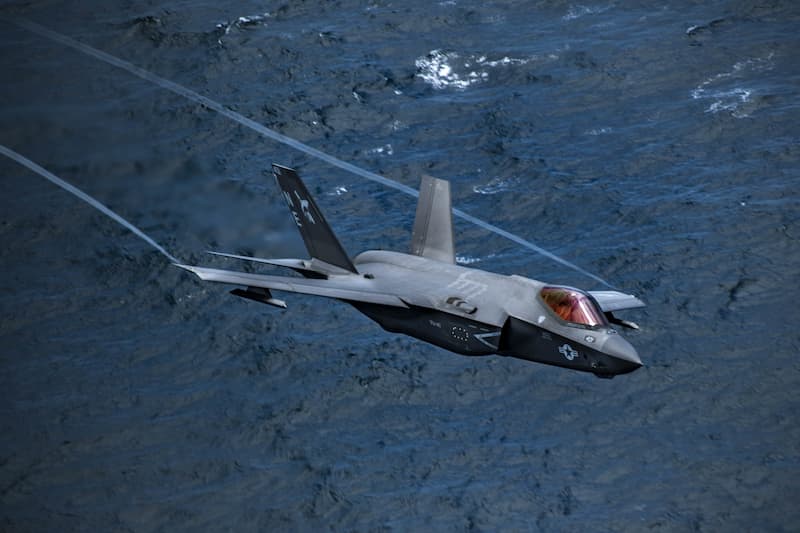
211017-N-HS181-1473 BAY OF BENGAL (Oct. 17, 2021) An F-35C Lightning II assigned to the “Argonauts” of Strike Fighter Squadron (VFA) 147 flies over the Bay of Bengal as part of Maritime Partnership Exercise (MPX) 2021, Oct. 17, 2021. MPX 2021 is a multilateral maritime exercise between the Royal Australian Navy, Japan Maritime Self-Defense Force, U.K. Royal Navy, and U.S. maritime forces, focused on naval cooperation, interoperability and regional security and stability in the Indo-Pacific and is an example of the enduring partnership between Australian, Japanese, U.K. and U.S. maritime forces, who routinely operate together in the Indo-Pacific, fostering a cooperative approach toward regional security and stability. (U.S. Navy photo by Mass Communication Specialist 2nd Class Haydn N. Smith)
図7 F-35CライトニングII
出典:米国海軍のWebサイト<Resources>Photo Gallery>からの画像
F-35ライトニングIIについては、以下をご参照ください。
番外編:世界最速マッハ3のSR-71と映画に出てくるDarkstar
「トップガン マーヴェリック」では、ダークスター(Darkstar)マッハ10超えを達成していますが、最高速度マッハ3世界最速のジェット機と言えば、SR-71ブラックバードです。

SR-71 Blackbird SR-71, unofficially known as the “Blackbird,” is a long-range, advanced, strategic reconnaissance aircraft. The first flight took place on Dec. 22, 1964. The U.S. Air Force retired its fleet of SR-71s Jan. 26, 1990, but returned them in 1995 until January 1997. Throughout its nearly 24-year career, the SR-71 remained the world’s fastest and highest-flying operational aircraft. (U.S. Air Force photo/Tech. Sgt. Michael Haggerty)
図8 SR-71ブラックバード
出典:USAF(米国空軍)のWebサイトからの画像
1988年頃だと思うのですが、沖縄でSR-71がゆっくりと旋回しながら降りていくのを実際に見たことがあります。真っ黒な機体でしかも遠目にみても随分大きな機体だと思っていました。
F-35ライトニングIIについては、以下をご参照ください。
「トップガン マーヴェリック」に出てくるダークスター(Darkstar)の壁紙が、Lockheed Martin社で公開されています。
4枚を編集したのが下図です。
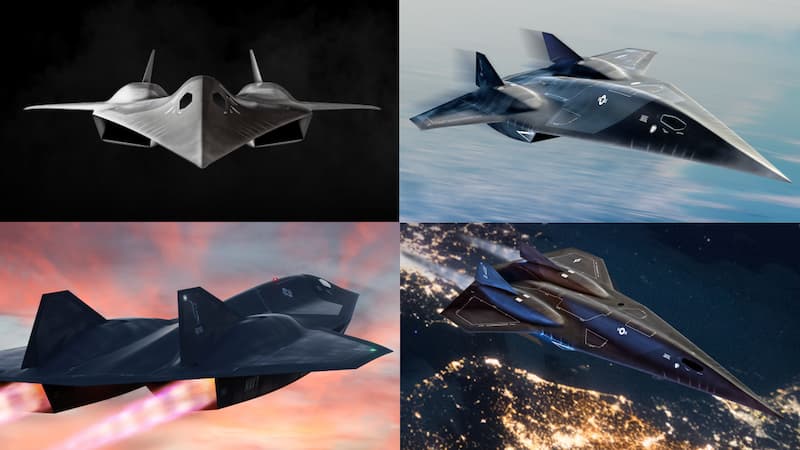
「トップガン マーヴェリック」に出てくるダークスター(Darkstar)
図9 「トップガン マーヴェリック」に出てくるダークスター(Darkstar)
出典:Lockheed Martin社のWebサイト記事「Top Gun – The Need for Speed」から(加工しています)
SR-71ブラックバードが、マッハ3でほぼ宇宙との境界を飛び、パイロットは宇宙服を着用しています。

マッハ3を超える速度で人を運べるのか、そもそも人は耐えられるのでしょうか?
Lockheed Martin社のDarkstarのWebページのリンクは、以下になります。

スカンクワークスについては、以下をご参照ください。
まとめ
2022年5月、トップガン2作目の「トップガン マーヴェリック」が公開されました。
「トップガン マーヴェリック」の主役機は、F/A-18スーパーホーネットですが、米国空母の艦載機としては、前作のF-14トムキャット以外にも、F/A-18スーパーホーネットのファミリー機でもある電子戦機EA-18G Growlerもありますが、最高速度マッハ3世界最速のジェット機SR-71ブラックバードの後継機?でもあるSR-72みたいなDarkstarも登場しています。
ここでは、「トップガン マーヴェリック」に関連する空母や艦載機などについて以下の項目で紹介しました。
- 滑走路からの離陸・着陸と空母からの発艦・着艦の違い
- 離陸と発艦の違い
- 着陸と着艦の違い
- 映画トップガン2作目の主役機:F/A-18スーパーホーネット
- F/A-18スーパーホーネット・ファミリーの電子戦機:EA-18G Growler
- ステルス機:F-35ライトニングII
- 番外編:世界最速マッハ3のSR-71と映画に出てくるDarkstar
